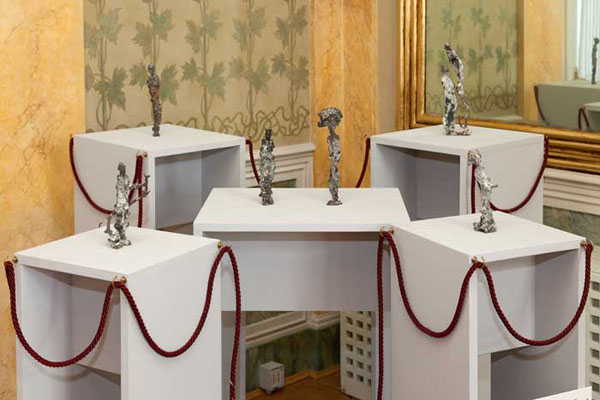Germany - Otto Fischer

The Spirit and the Material
The value of space in the works of Otto Fischer
The relation between material and form is crucial for Otto Fischer’s sculpture. In his work the artist brings integrates the surrounding space. The focus of the Venetian exhibition lies on the wise choice of the historical ambience: The German artist’s bronze figurines become the centre of the halls of Hotel Hungaria, a masterpiece of the Italian art nouveau, famous in Europe and the world for its colourful majolica façade from 1907. The sculptures harmonize with the atmosphere evoked by the spacious halls with well maintained frescos and decorations from the Belle Époque.
We would like to lay out Fischer’s artistic development by taking a closer look at his figurines, that are in a “mystic union” with the claustral spaces of an antique abbey as well as in community with a gothic palazzo, kept in a historical-architectonical union. Here the figurines were mostly immobile, fixed, rigorously frontal, sublime in their stately attitude. The bronze statuettes emancipate themselves from their severe roles imposed on them by the lofty space. Especially the figurines realized for OPEN 2011, with their corroded contours achieved by the lost wax process, suggest the vision of establishing an imagined dialog animating them. It is the author himself to introduce us to his world, imaginary and real at the same time: “The small formatted bronze figurines - the Saint, the Devil, the man with the turban, the graceful maid - tell of their heterogeneous origins while being associatively united in the special arrangement. The statuettes give the idea of a humane society, including religious, mystic and social aspects as well as dimensions of time and space. They draw the viewer’s attention to the basic elements of his life and are a source of aesthetic reflection as well as a poetic companion demanding life’s significance. The neutral grey pedestals holding the figurines are connected by a Venetian red cord symbolizing the bond between people, a safety rope. Passing from one pedestal to the next, the cord connects them, turning them into one single artwork, while paying homage to the old Venetian form of government: it is the thread that determines life”.
Fischer’s sculptures become the link between his work’s immanence and the echoes of a still effective bygone era. The scenario’s elegance elevates the event’s extraordinary character.
Text by
Nevia Capello